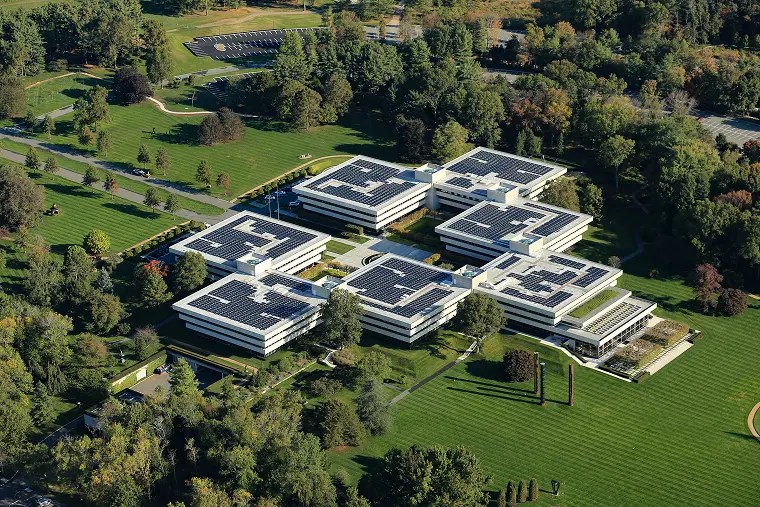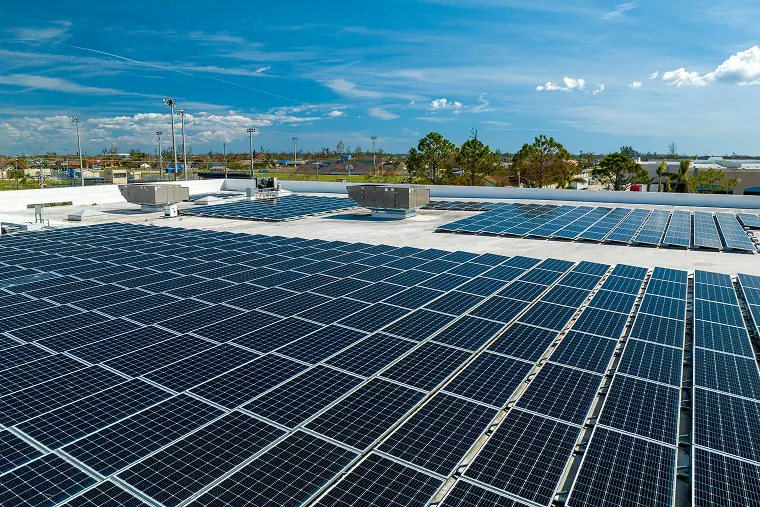Solar Solutions
Tap the potential of low-cost, emissions-free solar energy
Generating and using your own clean electricity provides financial savings, energy security, and sustainability.

Trusted by industry leaders












Let PowerFlex solve your business challenges

Solar allows you to hedge against fluctuating energy prices by essentially fixing the cost of your electricity for the lifetime of the system, which can last 25 years or more

By generating your own energy on your property, you can reduce reliance on utility lines that are prone to failure due to increasing demand and extreme weather events

Solar energy is 100% emissions free, enabling organizations to make good on carbon-reduction commitments and satisfy internal and public demands for increased sustainability

With community solar solutions, you can enjoy the financial and environmental benefits of solar energy even if your property lacks the space or suitability for an onsite system
Turning your workplace into a green energy hub involves many teams
We make it easy for everyone

Property Development Teams
Keep up with building codes and attract tenants with eco-friendly clean energy systems that are installed on time and budget

Sustainability Teams
Reduce carbon emissions, comply with regulations, and achieve ESG goals by generating and using onsite renewable energy

Operations Teams
Fold clean technologies into existing infrastructure with ease, and gain insights into performance with real-time monitoring

Fleet Teams
Decrease cost per mile, increase vehicle readiness, and leverage powerful telematics with intelligent EV charging

IT Teams
Easily and securely integrate the PowerFlex X™ intelligent energy management platform into your existing tech stack with public APIs

Drivers
Get the energy you need by the time you leave when you choose PowerFlex smart electric vehicle charging stations
Experience the PowerFlex difference
PowerFlex gives you control over your energy destiny, allowing you to make the transition to cleaner and more affordable electricity.
Creating a sustainable future, one project at a time

500+ MW

#2
Discover the benefits of PowerFlex commercial solar solutions

Quality Equipment at Affordable Prices
- Access supply chains and competitive pricing through PowerFlex’s global industry relationships
- Procure quality panels, racking, inverters, and other equipment that are built for 20+ years
- Receive maintenance and customer support once your system is online

Measurable Sustainability Progress
- Satisfy a portion of your building’s power demand with onsite energy
- Reduce carbon footprint by leveraging clean technologies
- Benefit from renewable energy through community solar options even if your property can’t support a system

Maximum Value Through Smart Engineering
- Improve the performance of your solar assets with intelligent hardware and software
- Optimize across multiple energy assets to achieve maximum output and cost savings
- Leverage onsite solar to the fullest and offset utility power usage

Unbeatable Project Success
- Enjoy turnkey and end-to-end cleantech solutions for your entire portfolio from a single national provider
- Take advantage of flexible financing options and solar energy incentives
- Recoup system costs often within 5 years with money saved on utility bills
Your partner throughout the project lifecycle
Turnkey or upgrade projects. Single properties or multi-site portfolios. No matter the project, PowerFlex is there with you every step of the way.
Single Site
1-2 months
Site Validation & Valuation
Assess site feasibility
Determine applicable policy incentives
Advise on local and federal policies
Create project economics model
Identify financing options
2-5 months
Site Development
Create/refine site design and building plans
Submit incentive program applications
Maximize incentive program funding
Track program funding
Arrange finance options
Secure utility approval
Secure permits, as applicable
Sign contracts
1-18 months
Engineering Procurement Construction (EPC)
Complete full engineering plans
Secure permitting from AHJ (authority having jurisdiction)
Hire construction contractors
Coordinate with onsite team
Procure all major equipment
Coordinate with utility for interconnection
Mobilize and build
Obtain COD (commercial operation date)
Asset Life
O&M and Asset Management
Define total scope
Sign contracts
Monitor and optimize energy assets
Dispatch O&M team as required
Manage warranties
Provide customer support
Manage ongoing incentives
Decommission energy assets responsibly
See how we implement solar solutions for top-tier customers
Learn about the intelligent platform that helps you get the most out of solar
PowerFlex X™
Optimize onsite energy assets for maximum performance, sustainability, and cost savings through our intelligent energy management platform, PowerFlex X™
Test Drive PowerFlex X™Break free from fossil fuels without breaking the bank
Cleantech solutions are more affordable to install than you might think. PowerFlex has the industry expertise to help make your green dreams a reality.
Incentives
Slash initial capex and operating costs
Our policy experts connect you with the most beneficial incentives and rebates at the federal, state, local, and utility levels
Explore IncentivesFINANCING OPTIONS
Multiple ways to afford your system
Take advantage of attractive financing arrangements — including ones with no upfront capital commitments
Explore Financing OptionsExplore more
Frequently Asked Questions

Commercial solar provides corporations, municipalities, nonprofits, and other organizations with clean, zero-emissions energy generated from the sun. Commercial solar energy systems differ from residential systems in that they are much larger and are designed to support facilities like workplaces, distribution centers, hospitals, and other buildings with substantial power needs.

There are many financial and environmental benefits to implementing a commercial solar system. By using clean electricity to help power your building and reduce your reliance on the utility grid, you can lower your operating costs and curtail your greenhouse gas emissions. Installing solar is also an easy public relations win, as it demonstrates your commitment to sustainability to employees, customers, and investors.

The size of a commercial solar system depends on the amount of available roof or property space, the annual power needs of the facility, and other specifics that are unique to each customer. An experienced solar solutions provider like PowerFlex can design a system that maximizes energy production with regard to these factors.

Many things affect the cost of a commercial solar solution, including but not limited to, the types of solar panels being installed, the size and condition of the building’s roof, permitting requirements, and labor. Federal, state, and utility-level incentives are available to help defray these costs, which, along with money saved on electricity bills, can produce a strong return on investment.

How commercial solar panels are installed depends on the system type. Panels can be installed on top of a building (rooftop system), on unused land (ground-mounted system), or over a parking lot or garage (solar parking canopy). Installation methods can vary depending on roof type, ground conditions, available space, and other factors. PowerFlex conducts extensive site validation and development to ensure smooth and efficient installations no matter the system type.

Solar panels generate electricity through the photovoltaic effect. Photons of sunlight strike the cells in a solar panel and knock electrons loose. The electrons flow one after the other through the interconnected modules to generate direct current electricity. To make the energy compatible for use with commercial equipment, a device called an inverter changes the direct current (DC) electricity into alternating current (AC) electricity.

Under normal operating conditions and with proper preventative maintenance, commercial solar panels and systems can last 25 years or more — making a solar project an excellent long-term investment.

By providing your building with emissions-free electricity, a commercial solar system can offset a significant portion of your annual energy consumption. The exact amount will depend on the size of your system, your specific energy goals, the amount of sunlight your property receives, and other details. But don’t worry, PowerFlex’s solar experts will work with you to design a system that’s right for you.

Yes, you will still receive a monthly bill reflecting any electricity you consume from the grid, but since solar is fulfilling a chunk of your power demand, your energy expenses will be significantly lower. In areas with net metering programs, your bill will also reflect any credits you may have received for exporting surplus electricity to the grid.

Incentives for installing commercial solar solutions are available on the federal, state, and local utility levels. The Investment Tax Credit entitles system owners to a federal tax credit equal to 30% of the total system cost, or even more if certain criteria are met. For information on state and utility incentives for which you might be eligible, consult our Policy Hub.

Yes, customers can take advantage of various financing options such as solar leases, power purchase agreements (PPAs), loans, and other opportunities to reduce or even completely avoid upfront costs. Consult our blog to learn more about commercial solar financing and which option might be best for you.

A commercial solar installation offers great return on investment, typically paying for itself in 5 to 7 years thanks to energy cost savings, tax credits, and available incentives.

Yes, our customers can monitor the performance of their system with the PowerFlex X™ adaptive energy management platform. PowerFlex X provides easy access to all your solar energy data through an online dashboard, allowing you to keep tabs on your system right from your desktop.

If your system is located in a state that allows net metering, you may be able to send any surplus energy your system produces into the grid in exchange for credits on your electricity bill. Another option is to install a battery energy storage system that can store surplus energy to be used later in the day, when solar production tapers off. Energy storage also allows you to take advantage of utility price fluctuations by using “free” solar energy to power your building during the peak evening hours, when grid electricity is often most expensive.

Since solar energy systems are interconnected with the power grid, your solar panels will stop generating electricity during blackouts to ensure the safety of power company technicians who might be working on the utility lines. However, with the addition of energy storage and microgrid infrastructure, your system can “island” itself from the grid and continue to provide electricity to your building.









.png)